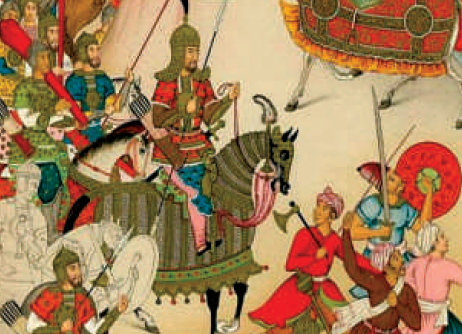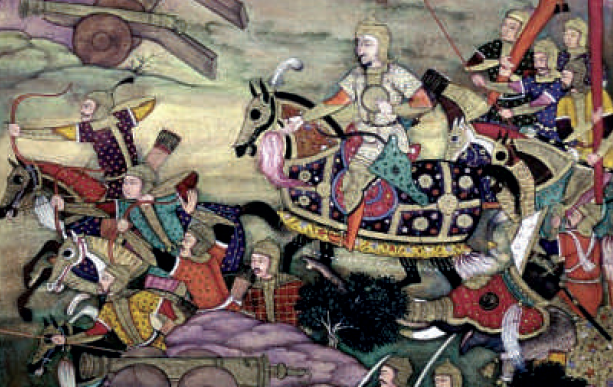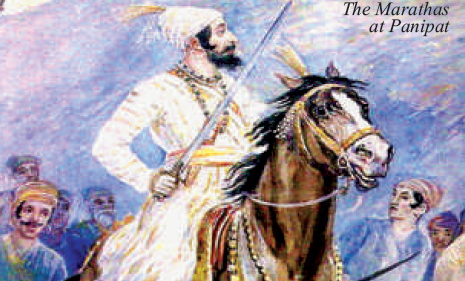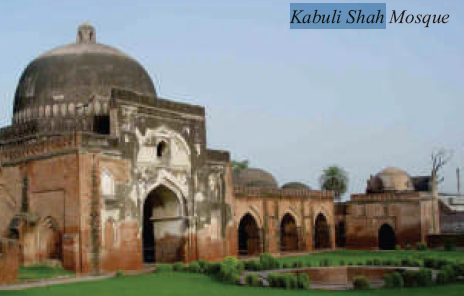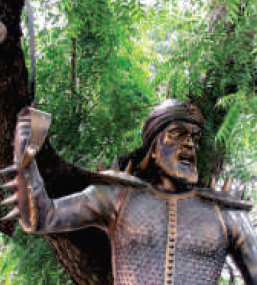Panipat: battles of
This is a collection of articles archived for the excellence of their content. Readers will be able to edit existing articles and post new articles directly |
Contents |
Panipat
First Battle of Panipat
Panipat Wars and political upheaval
India Harmony Volume - 1 : Issue - 5 July-August, 2012
The legendary city of Panduprastha has in later times come to be known as Panipat. Legend has it that at the time of the battle of Mahabharata, five villages were demanded by the Pandavas from Duryodhana of which one was “Panipat”. This developed into one of the five cities-“prasthas”- founded by the Pandava brothers.
Panipat has been witness to many a major battles since the early 12th century. This little town has been the site for most of the battles for power in India. The name of this city occupies primacy in Indian history at a later period because three famous pivotal battles of Panipat were fought here over the two centuries between 1526 to 1756. But not many people know that it has been renowned for its intellectual and spiritual heritage, since the days of the early Muslim incursions into India in the twelfth century. The foreign armies brought with them spiritual seekers called Sufis. They settled here long before the Afghans and Sultans made this their home. Panipat was an ideal battleground for those who invaded India from the North and those who defended the country from the South. It lay on a piece of relatively high ground and between vast marshes on the West and the River Yamuna on the East. There was no good direct road to it; so it was not suitable for trade or commerce. Therefore, besides being a suitable battle ground, it was also a safe haven for Sufis.
In the 12th and 13th centuries the Afghans and Turkish armies established the Sultanate reign in Delhi. The Slave dynasty ruled over the entire northern and central India. This period ushered in an Indo-Islamic culture that left a rich legacy from fusion in art, architecture and literature. The Urdu language, which is a blend of the local Sanskrit/Prakrit spoken at that time and the Persian/Arabic languages of the immigrants, is also generally considered a heritage from the Sultanate period.
From the 13th through the early 16th centuries, the Delhi Sultanate was the dominant power in the Indian subcontinent. In addition to espousing a unique Indo-Islamic culture, the Delhi Sultanate maintained a certain degree of stability in the subcontinent, especially in North India. However, this period gave way to Mughal rule in 1526 when an ambitious conqueror by the name of Babur crushed the armies of the Lodhi Dynasty at the fields of Panipat, creating one of the largest power vacuums in Indian history. Here, India's history could have diverged spectacularly, as different factions competed for the spoils. Ultimately, it was Babur's grandson Akbar who would emerge triumphant and consolidate Mughal power.
Babur, a descendant of Timur and Genghis Khan came from the Fergana Valley (modern day Uzbekistan) across the Khyber Pass. India then had a large Delhi Sultanate ruled by Ibrahim Lodhi and Lahore (now in Pakistan) had a Lodhi Governor, Daulat Khan Lodhi. Babur won a succession of battles and made his intention clear of capturing Delhi. Babur had attempted to capture Delhi more than once but had lacked the resources to mount a sufficiently large expedition. However, the steady decline in popularity of Delhi's Sultan Ibrahim was a factor working strongly in Babur's favour. Babur seized the opportunity by uniting his followers in an adventure which, if successful, would offer them boundless wealth.
The ruler of Delhi Ibrahim Lodhi decided to oppose Babur at Panipat. He had great confidence in his elephant corps. He thus marched from Delhi to accost Babur. The battle at Panipat has gone down in history as a watershed as Babur faced a much larger force of 100,000 along with a vast elephant corps.
Babur had a force only 24,000 but he had lined up cannons which at that time were an unknown commodity in India. In addition like a shrewd general he chained all the guns together so that Lodhi's elephant corps could not break through. The battle was swift and Babur opened up with his guns. The ensuing smoke and sound of gun fire had a deleterious effect on the elephant corps and the much needed elephant charge never took place. Ibrahim Lodhi was killed in battle and his army defeated in half a day. Babur entered Delhi triumphantly. Babur's guns and fine skills as a commander brought him a well deserved victory which changed the course of Indian history. Humayun, the eldest son of Babur, was dispatched to seize Sultan Ibrahim's household and treasure at Agra while Babur, himself, advanced on Delhi.
Babur's Mughal Empire, would one day cover modern day Afghanistan, Pakistan, India and Bangladesh. His decisive victory in the First Battle of Panipat resulted in enormous political upheaval in North India, with various factions vying to fill the power vacuum created by the collapse of the Delhi Sultanate. Having died just five years after this great victory, Babur was unable to consolidate his conquests. His successor Humayun also failed, facing enormous competition from the Suri dynasty. Humayun was defeated by the Afghan warrior Sher Shah Suri in the year 1540, and was forced to retreat to Kabul.
Dec 15, 2019 ‘'Panipat Government Site
The First Battle of Panipat was fought between the invading forces of Babur and the Lodi Empire, which took place on 21 April 1526 in North India. It marked the beginning of the Mughal Empire. This was one of the earliest battles involving gunpowderfirearms and field artillery.
‘Details'
In 1526, the Mughal forces of Babur, the Timurid ruler of Kabulistan, defeated the much larger ruling army of Ibrahim Lodi,Sultan of Delhi. The battle was fought on 21 April near the small village of Panipat, in the present day Indian state of Haryana, an area that has been the site of a number of decisive battles for the control of Northern India since the twelfth century.
It is estimated that Babur’s forces numbered around 15,000 men and had between 20 to 24 pieces of field artillery. Babur estimated Lodi had around 100,000 men, though that number included camp followers, while the fighting force was around 30,000 to 40,000 men in total, along with at least 1000 war elephants.
Advantage of Cannons in the Battle
It is generally held that Babur’s guns proved decisive in battle, firstly because Ibrahim Lodi lacked any field artillery, but also because the sound of the cannon frightened Lodi’s elephants, causing them to trample Lodi’s own men. However a reading of the contemporary sources show that more than the gun, it was the tactics which helped in winning the day. The new war tactics introduced by Babur were the tulughma and the araba. Tulughma meant dividing the whole army into various units, viz. the Left, the Right and the Centre. The Left and Right divisions were further subdivided into Forward and Rear divisions. Through this a small army could be used to surround the enemy from all the sides. the Centre Forward division was then provided with carts (araba) which were placed in rows facing the enemy and tied to each other with animal hide ropes. Behind them were placed cannons protected and supported by mantelets which could be used to easily manoeuvre the canons. These two tactics made Babur’s artillery lethal. The guns and cannons could be fired without any fear of being hit as they were shielded by the bullock carts which were held in place due to the hide ropes holding them together. the nozzle of the heavy cannons could also be easily changed as they could be manoeuvered by the mantelets which were provided with wheels.
Ibrahim Lodi died on the field of battle, abandoned by his feudatories and generals (many of whom were mercenaries). Most of them changed their allegiance to the new master of Delhi. However had Sultan Ibrahim survived another hour of fighting he would have won, as Babur had no reserves and his troops were rapidly tiring.
The second battle of Panipat
In this chaotic environment for a brief period, Emperor Hemu Vikramaditya, came to power who attempted to recreate a new empire in North India. After Sher Shah's death, his son Islam Shah Suri together with Samrat Hem Chandra Vikramaditya, won 22 battles against Afghan rebels and forces of Akbar. Hemu after a succession of victories against the Sultans had entered Delhi and was crowned as King in the Purana Quila –the fort built by Sher Shah Suri. They ruled from Punjab to Bengal, had succeeded establishing a secular rule in North India from Delhi. However, in 1556, Babur's grandson Akbar rose to the challenge and decisively defeated Hemu, thus consolidating the Mughal Empire. Akbar who was just 13 years old faced Hemu along with his regent and general - Bairam Khan. The setting for the second great battle was again at Panipat. The battle is of great historical importance as Hemu straight away went on the offensive. Repeated charges by the elephant corps of Hemu soon had the Mughal army in disarray. Despondency set in and the Mughals were thinking of breaking battle and retreating. Hemu proved himself an able commander as he directed the battle from the vantage point of his elephant skillfully. But then providence took a hand and a stray arrow hit Hemu's eye and he was rendered unconscious. This had a deleterious effect on his army and the Mughals converted a lost battle into victory. Akbar's forces defeated and killed Hemu in the Second Battle of Panipat on 6 November 1556 and re-established Moghul rule.
Thereafter, The Mughal Empire became the dominant power in the Indian subcontinent between the mid-16th century and the early 18th century.
Second Battle of Panipat (1556)
The Second Battle of Panipat was fought between the forces of Samrat Hem Chandra Vikramaditya, popularly calledHemu, the Hindu king who was ruling North India from Delhi, and the army of Akbar, on November 5, 1556. It was a decisive victory for Akbar’s generals Khan Zaman I and Bairam Khan.
‘Background'
On January 24, 1556, the Mughal ruler Humanyun died in Delhi and was succeeded by his son, Akbarat Kalanaur, who was only thirteen years old. On February 14, 1556, Akbar was enthroned as the king. At the time of his accession to the throne, the Mughal rule was confined to Kabul, Kandahar, parts ofDelhi and Punjab. Akbar was then campaigning in Kabul with his guardian, Bairam Khan.
Samrat Hem Chandra Vikramaditya or Hemu was a Hindu emperor in Delhi by virtue of defeating Akbar/Humanyun’s army in Battle for Delhi. Hemu belonged to Rewari in present day Haryana, who earlier was an adviser to Sher Shah Suri’s son Islam Shah from 1545 to 1553. Hemu had won 22 battles, as Prime Minister and Chief of Army of Islam Shah, during 1553 to 1556 to quell the rebellion by Afghan rebels against Sur regime. At the time of Humayun’s death in January 1556, Hemu had just quelled a rebellion in Bengal, killing the Bengal ruler Muhammad Shah in the war. He made his intentions of winning Delhi for himself known to his commanders. He then started a campaign, winning battles throughout northern India. When he attacked Agra, the commander of Akbar’s forces inAgra, fled without fighting. A large area of Etawah, Kalpi, and Agra provinces comprising present day Bihar and UP came under Hemu’s control. In the Gwalior Fort Hemu consolidated his army by recruiting more Hindus.
Hemu then moved towards Delhi and stationed his forces outside the city at Tughlaqabad. On October 6, 1556, army encountered Mughal resistance. After a fierce fight Akbar’s forces were ousted, and Tardi Beg, the commander of the Mughal forces, escaped, allowing Hemu to capture Delhi. Around 3,000 Mughals were killed. Hemu was crowned at Purana Qila on October 7, 1556, and established Hindu rule in North India, after 350 years of Muslim rule, and was bestowed the title of Samrat Hem Chandra Vikramaditya. According to Abul Fazl in Akbarnama, Hemu was preparing for an attack on Kabul and made several changes in his army.
‘’'Battle
Developments in Delhi and Agra disturbed the Mughals at Kalanaur, Punjab. Many Mughal Generals advised Akbar to retreat to Kabul as Mughal forces may not face Hemu’s might and new awareness among Hindus to liberate their country, but Bairam Khan decided in favor of war. Akbar’s army marched towards Delhi. On November 5, both armies met at the historic battlefield of Panipat, where, thirty years earlier, Akbar’s grandfather Babur had defeated Ibrahim Lodi in what is now known as the First Battle of Panipat. H.G.Keen writes; “Akbar and his guardian Bairam Khan did not participate in the battle and were stationed 5 Kos (8 miles) away from the war zone. Bairam Khan did not permit the 13 year old child King to be present in battle field in person, instead he was provided with a special guard of 5000 well trained and most faithful troops and was stationed at a safe distance far behind the battle lines. He was instructed by Bairam Khan to flee towards Kabul for life in case the Mughal Army was routed in the battlefield.”[3] Hemu led his army himself. Hemu’s army consisted of 1500 war elephants and a vanguard of artillery park. Hemu marched in excellent order with 30,000 practiced horsemen composed of Rajputs and Afghans who on many occasions, had by their exploits increased the pride and arrogance.
In order to hearten the soldiers and the Afghan Amirs, Hemu had given gifts of lands, and opened the doors of his treasures. Thus he mobilised the valiant fighters. According to Badaoni, Hemu’s army was dispirited, and who set all his hopes on the elephants, surrounded by his chiefs charged the imperial hosts, and threw both right and left wings in to great confusion. The Mughal forces were charged repeatedly by elephants to break their lines. The Mughal Vanguard according to sources consisted of 10,000 cavalry, out of which 5000 were experienced veteran soldiers and they got ready to meet the advancing army of Hemu. Hemu was himself commanding his forces from atop an elephant. It seemed Hemu was on a winning track and Akbar’s army would rout. Abul Fazl has described the war as quote “Two armies so collided that they struck fire out of water, You’d say the air was all crimsoned. Their steel had all become solid rubies” suddenly in the midst of the contest, an arrow from the bend bow of divener wrath reached Hemu’s eye, and piercing the socket, came out at the back of his head. In the words of Badaoni too, “suddenly the arrow of death which no shield can ward off struck his (Hemu) squinting eye so that his brain passed clean out from the cup of his head, and he became unconscious and not to be seen in his Howda. Not seeing Hemu in his howda, Hemu’s army was in disarray and defeated in the ensuing confusion.
Several hours after the war ended, dead Hemu was located and captured by Shah Quli Khan Mahram and brought to Akbar’s tent in the camp located at village Saudhapur in Panipat (Located on Panipat-Jind road, 5 km from NH1). General Bairam Khan was desirous that Akbar should slay the hindu king Hemu himself and should establish his right to the title of “Ghazi” (Champion of Faith or war veteran). But Akbar, refused to strike a blood soaked and dead enemy but smote the dead body, just to be called a Ghazi. Bairam Khan irritated by Akbar’s scruples beheaded the king himself.
Hemu’s supporters constructed a Cenotaph at the site of his beheading, which still exists at the village Saudhapur, on Jind Road at Panipat.
The third battle of Panipat
Mughal rule entered its twilight after the demise of Aurengzeb and his successors had to face concerted attacks from the Marathas. The Maratha confederacy existed from 1674 to 1818. The third and the final battle of Panipat was fought on January 14th, 1761 was between the forces of the Maratha Confederacy and the coalition of the kings of Afghanistan, Ahmad Shah Durrani (also known as Ahmed Shah Abdali) and his two Indian allies; The Rohilla Afghans of Doab and the Nawab of Oudh, Shuja-ud-Saula. The battle was fought at Panipat.
The third battle of Panipat is known to be one of the largest battles fought in the 18th century and perhaps has the largest casualties in a single day reported in a classic formation between two armies. What followed were a string of clashes by the banks of the Yamuna River, including the Battle of Kunjipur, which the Marathas won, against an Afghan army of about 15000 men. Abdali and other Afghan forces were on the eastern side of the Yamuna, however Abdali daringly crossed over the river on October 25th at Baghpath, cutting off the Maratha camp from their base in Delhi. This led to a two month long siege led by Abdali against the Marathas in the town of Panipat. Finally, faced with starvation, the Marathas marched towards the Afghan camp. The two armies came face to face at 8 am and the war waged on till the evening resulting in victory for Ahmad Shah Abdali and his army.
The result of the war was that the Maratha advances over North India were halted and their territories were destabilized. Sadashiv Rao Bhau was killed in the war. His body was recovered by the Afghans and under the personal direction of Ahmad Shah was cremated according to Hindu customs. The third battle of Panipat saw an enormous number of casualties and deaths in a single day of battle. This was the last major battle between indigenous South Asian military powers until the creation of Pakistan in 1947.
The Third Battle of Panipat in 1761, like the First, created a huge power vacuum in India. The battle marked the beginning of the decline of the Marathas, who would be progressively weakened in three devastating wars against the British. However, the battle proved costly for both sides, and weakened the Durranis as well as the Marathas. The weakening of India's largest powers in this battle was more crucial to the overall British success in India than the Battle of Plassey itself. After 1761, conflicts in India would almost exclusively involve the British.
The Third Battle of Panipat set in stone a distinct cultural gap in the subcontinent. For most of history, the area corresponding to modern-day Afghanistan and Pakistan's tribal areas were considered the "natural frontiers" of India. Unsurprisingly, Indian empires with their base of power in the Indo-Gangetic Plain had their political frontiers in those regions, and the people of the frontiers were considered to be highly Indianized. This changed in the 18th century, when the collapse of the Mughal Empire, coupled with the rise of tribal Afghan dynasties like the Durranis, permanently pulled the frontier regions out of the cultural orbit of the Gangetic states. The repercussions of this highly significant development can still be felt today. The three crucial battles in Panipat practically changed the history of the subcontinent – the first two consolidating Mughal power and the last one ushering in British reign.
Present day Panipat has a war museum and memorial, the Kabuli mosque, the tomb of Ibrahim Lodhi among other historical sites. Ibrahim Lodi is buried here after he was defeated by Babur in 1526. His grave is a simple tomb; just a rectangular block on a high platform approached by a flight of steps made of lakhori bricks. The tomb was renovated by the British in 1866.
The Kabuli Shah mosque was built by Babur after his victory over Ibrahim Lodhi. He named the mosque after his wife Kabuli Begum. Six years later when Humayun defeated Salim Shah, he got a platform called Chabutara Fateh Mubarak made around the mosque. The mosque has chambers on two sides and an inscription in Persian runs along the parapet.
Dec 15, 2019 ‘'BL UK Drawing of the battle of Panipat, 14 January 1761, by an anonymous artist in the Faizabad style, dated c.1770. Inscribed with the names of the principal combatants in Persian characters. The drawing is done with some colour; on paper backed with cloth, through which can be seen a drawing of a horseman and attendant. Ahmad Shah Durrani and his forces are defeating ShadaSiva Bhao and the Maratha armies; Ahmad Shah Durrani rides a brown stallion surrounded by his close supporters. On his left are Najib Khan and Shuja' al-Daula with their forces, on his right are Ahmad Khan Bangash and Hafiz Rahmat, before them a cavalry attack is made by Shah Wali Khan. Within the buildings of the Panipat camp troops are raping and committing atrocities while outside the wounded Bhao is helped from his horse; the centre of the picture is dominated by the arc of the two lines of guns with smoke and devastation between them. In 1760 the Marathas occupied Delhi, having already conquered the Punjab, offering a serious threat to the Muslim domination of the north of India. Their leader Viswas Rao was being advised by Sadasiva Bhao who organised the Maratha army under his generalship. To oppose them an army was formed by a Muslim alliance between Shuja' al-Daula of Oudh, Ahmad Shah Durrani and the Rohilla Afghans. Under the threat the Bhao fixed his camp and headquarters at Panipat in October 1760, which proved to be a tactical error. By January the Maratha army and its supporters were suffering famine under siege conditions, and they were obliged to start the offensive. Ahmad Shah's victory was decisive and the slaughter enormous.
